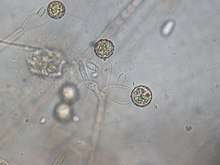Monoblepharidomycetes
Members of the Monoblepharidomycetes have a filamentous thallus that is either extensive or simple and unbranched. They frequently have a holdfast at the base. In contrast to other taxa in their phylum, some reproduce using autospores, although many do so through zoospores. Oogamous sexual reproduction may also occur.[4]
| Monoblepharidomycetes | |
|---|---|
 | |
| Monoblepharis polymorpha growing on a sesame seed in water collected from a vernal pool near Orono, Maine. Shown are the spiny, brownish resting spores sitting on top the empty oogonia. On the sides of the oogonia are empty antheridia. | |
| Scientific classification | |
| Kingdom: | Fungi |
| Division: | Chytridiomycota |
| Class: | Monoblepharidomycetes J.H. Schaffner 1909[1] |
| Order: | Monoblepharidales (J. Schröt. 1893[2]) Sparrow 1943[3] |
| Type species | |
| Monoblepharis spp. Cornu 1871 | |
In addition to the type genus, the order Monoblepharidales includes Harpochytrium and Oedogoniomyces.[4]
Taxonomy
Based on the work of "The Mycota: A Comprehensive Treatise on Fungi as Experimental Systems for Basic and Applied Research"[5] and synonyms from "Part 1- Virae, Prokarya, Protists, Fungi".[6]
- Class Monoblepharidomycetes Schaffner 1909
- Order Harpochytriales Emerson & Whisler 1968
- Family Oedogoniomycetaceae Barr 1990
- Genus Oedogoniomyces Kobayasi & Ôkubo 1954
- Family Harpochytriaceae Emerson & Whisler 1984
- Genus Harpochytrium Lagerheim 1890 [Fulminaria Gobi 1900; Rhabdium Dangeard 1903 non Wallroth 1833]
- Family Oedogoniomycetaceae Barr 1990
- Order Monoblepharidales Schröter 1883
- Family Monoblepharidaceae Fischer 1892
- Genus Monoblepharis Cornu 1871 [Diblepharis Lagerheim 1900; Monoblephariopsis Laibach 1927]
- Family Gonapodyaceae Petersen 1909
- Genus Gonapodya Fischer 1892
- Genus Monoblepharella Sparrow 1940
- Family Telasphaerulaceae Longcore et T.Y. James 2017
- Genus Telasphaerula Longcore et T.Y. James 2017
- Family Sanchytriaceae Karpov et Aleoshin
- Genus Sanchytrium Karpov et Aleoshin
- Family Monoblepharidaceae Fischer 1892
- Order Harpochytriales Emerson & Whisler 1968
gollark: I'm just going to assume it's a bizarre visual effect and ignore it.
gollark: I'm not hovering. I don't think that works on my phone.
gollark: This page is incredibly weird. The text somehow looks like it's moving.
gollark: Is there a list of existing badge things somewhere?
gollark: Yes (UTC).
References
- Ohio Nat. 9: 449. 1909. Missing or empty
|title=(help) (as "Monoblepharidiae") - Engler & Prantl (1893). Nat. Pflanzenfam. 1: 106. Missing or empty
|title=(help), as "Monoblepharidineae" - Sparrow, F.K. (1943). Aquatic Phycomycetes exclusive of the Saprolegniaceae and Pythium. Ann Arbor: University of Michigan Press.
- Hibbett, D.S.; et al. (March 2007). "A higher level phylogenetic classification of the Fungi". Mycol. Res. 111 (5): 509–547. CiteSeerX 10.1.1.626.9582. doi:10.1016/j.mycres.2007.03.004. PMID 17572334.
- Esser K (2014). The Mycota VII A: Systematics and Evolution (2nd ed.). Springer. p. 461. ISBN 978-3-642-55317-2.
- "Part 1- Virae, Prokarya, Protists, Fungi". Collection of genus-group names in a systematic arrangement. Archived from the original on 14 August 2016. Retrieved 30 June 2016.
This article is issued from Wikipedia. The text is licensed under Creative Commons - Attribution - Sharealike. Additional terms may apply for the media files.